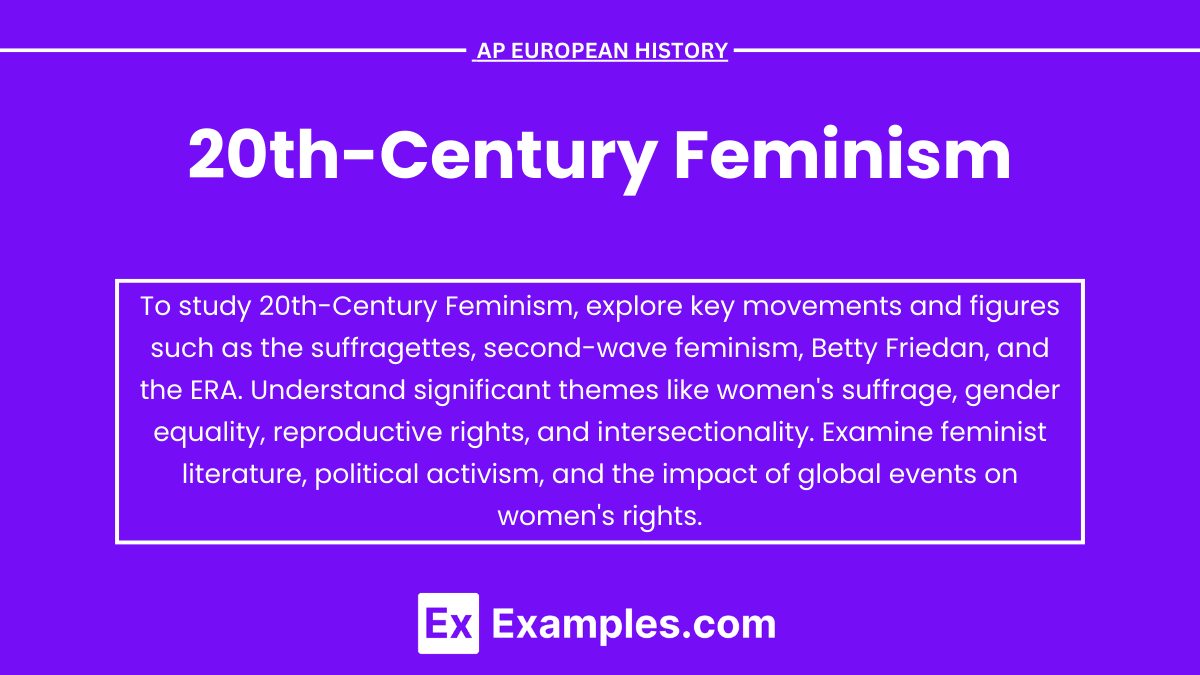20th-century feminism was a transformative movement that sought to achieve gender equality and address women's rights across various spheres such as politics, economics, and culture. This era saw the rise of multiple feminist waves, each targeting different aspects of gender inequality. Key issues included women's suffrage, reproductive rights, and workplace equality. Understanding these movements is essential for students of AP European History as they explore the social and political changes that shaped contemporary Europe and the world.
Learning Objectives
Understand the evolution and impact of 20th-century feminism in Europe, including key movements, figures, and legislation. Analyze the socio-political context of each feminist wave, focusing on issues like suffrage, reproductive rights, and intersectionality. Evaluate the contributions of influential feminists like Simone de Beauvoir and Angela Davis. Assess how feminism reshaped cultural norms, gender roles, and legal frameworks, contributing to greater gender equality and social change in Europe throughout the 20th century.
20th-Century Feminism
20th-century feminism marked a significant shift in the fight for women's rights, addressing issues such as political representation, economic equality, reproductive rights, and cultural stereotypes. This movement evolved through distinct waves, each focusing on different aspects of gender inequality.
First Wave Feminism (Late 19th - Early 20th Century)
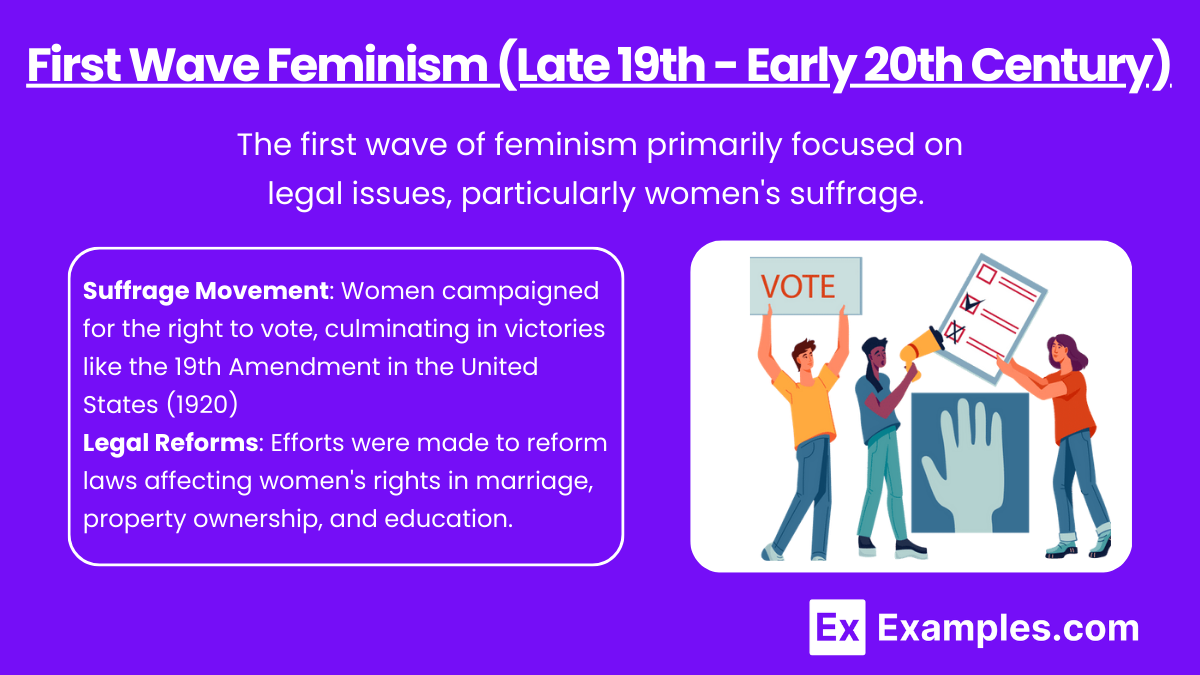
The first wave of feminism primarily focused on legal issues, particularly women's suffrage. Key milestones included:
Suffrage Movement: Women campaigned for the right to vote, culminating in victories like the 19th Amendment in the United States (1920) and similar successes in Europe, such as the Representation of the People Act 1918 in the UK.
Legal Reforms: Efforts were made to reform laws affecting women's rights in marriage, property ownership, and education.
Second Wave Feminism (1960s - 1980s)
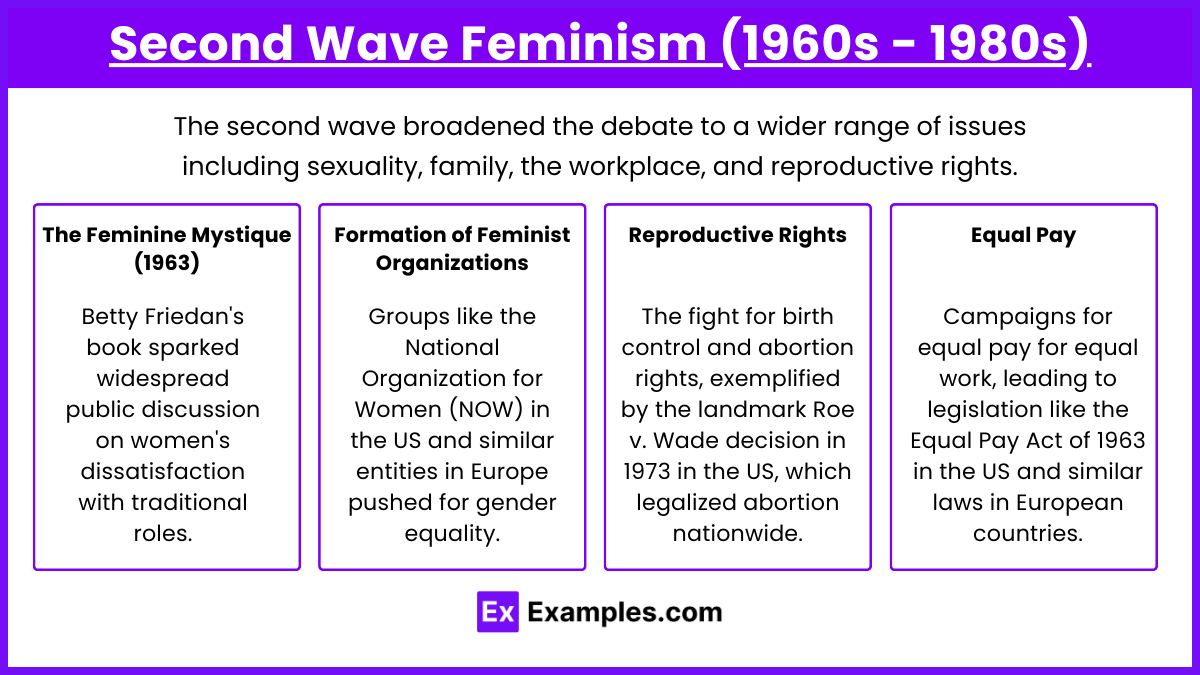
The second wave broadened the debate to a wider range of issues including sexuality, family, the workplace, and reproductive rights. Key elements included:
The Feminine Mystique (1963): Betty Friedan's book sparked widespread public discussion on women's dissatisfaction with traditional roles.
Formation of Feminist Organizations: Groups like the National Organization for Women (NOW) in the US and similar entities in Europe pushed for gender equality.
Reproductive Rights: The fight for birth control and abortion rights, exemplified by the landmark Roe v. Wade decision in 1973 in the US, which legalized abortion nationwide.
Equal Pay: Campaigns for equal pay for equal work, leading to legislation like the Equal Pay Act of 1963 in the US and similar laws in European countries.
Third Wave Feminism (1990s - 2010s)
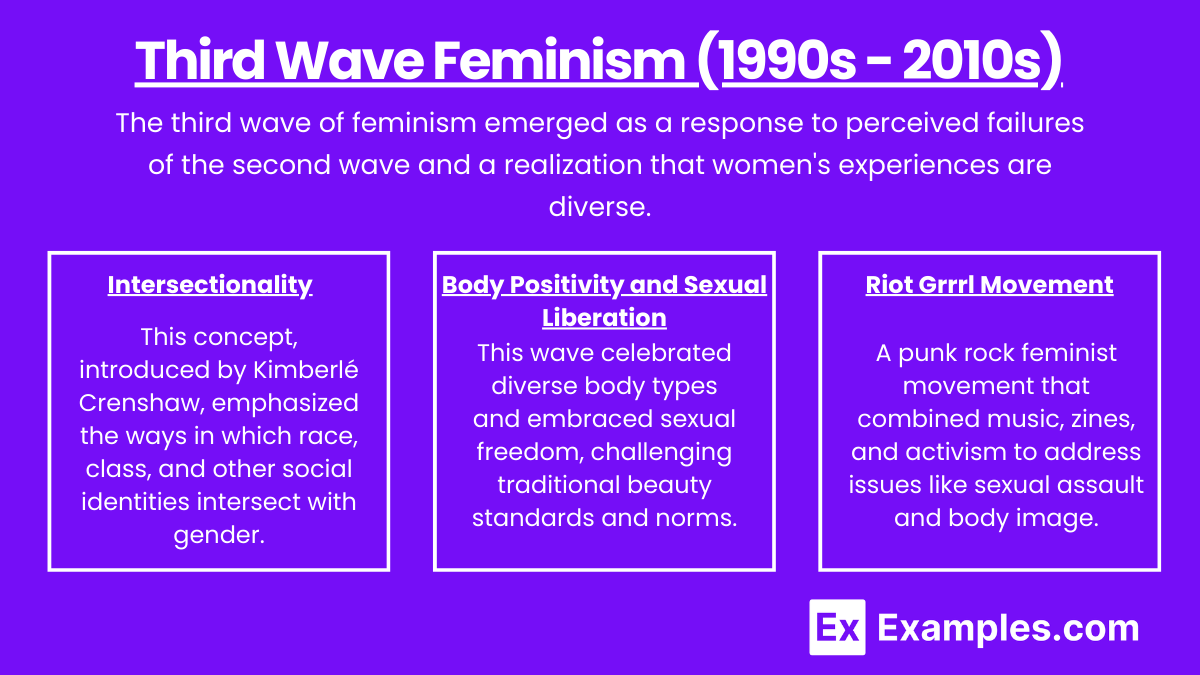
The third wave of feminism emerged as a response to perceived failures of the second wave and a realization that women's experiences are diverse.
Intersectionality: This concept, introduced by Kimberlé Crenshaw, emphasized the ways in which race, class, and other social identities intersect with gender.
Body Positivity and Sexual Liberation: This wave celebrated diverse body types and embraced sexual freedom, challenging traditional beauty standards and norms.
Riot Grrrl Movement: A punk rock feminist movement that combined music, zines, and activism to address issues like sexual assault and body image.
Fourth Wave Feminism (2010s - Present)

The fourth wave is characterized by the use of technology and social media to advance gender equality.
Digital Activism: Campaigns like #MeToo and #TimesUp brought attention to sexual harassment and assault, leveraging social media to create global movements.
Focus on Intersectionality: Continued emphasis on the diverse experiences of women, particularly marginalized groups.
Gender Identity: Greater recognition and support for transgender and non-binary individuals within the feminist movement.
Key Figures in 20th-Century Feminism
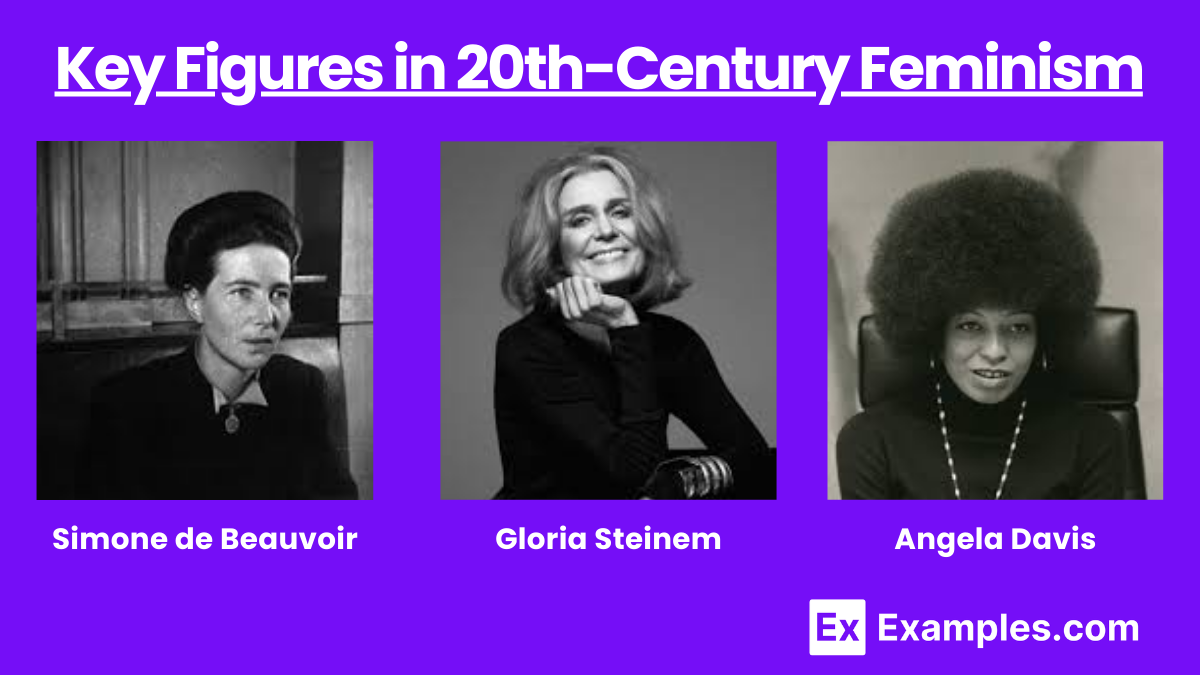
Simone de Beauvoir: Her book "The Second Sex" (1949) was crucial in developing feminist existentialism and the theory of gender as a social construct.
Gloria Steinem: A leading figure in the second wave, Steinem co-founded Ms. magazine and advocated for women's rights through her writings and activism.
Angela Davis: A prominent activist and scholar, Davis's work intersected feminism with civil rights, focusing on issues like prison reform and racial justice.
Impact of 20th-Century Feminism
The feminist movements of the 20th century led to significant societal changes:
Legislation: Numerous laws were passed to protect women's rights, including anti-discrimination laws, reproductive rights, and protections against domestic violence.
Cultural Shifts: The movement challenged and changed cultural norms about gender roles, contributing to greater acceptance of women in various professional fields.
Education and Employment: Increased access to education and employment opportunities for women, narrowing the gender gap in these areas.
20th-century feminism was a dynamic and multifaceted movement that significantly advanced women's rights and gender equality. Its legacy continues to influence contemporary feminist thought and activism, ensuring that the fight for equality remains a critical issue in the 21st century.
Examples
Example 1. The Suffrage Movement (Early 1900s)
The suffrage movement was a pivotal campaign in the early 20th century, advocating for women's right to vote. Key events include the ratification of the 19th Amendment in the United States in 1920, granting women the right to vote, and the Representation of the People Act 1918 in the UK, which began to enfranchise women.
Example 2. The Feminine Mystique by Betty Friedan (1963)
Betty Friedan's groundbreaking book, "The Feminine Mystique," sparked widespread discussions about women's roles and dissatisfaction with domestic life. This work is often credited with igniting the second wave of feminism in the United States, leading to greater advocacy for women's rights and equality in the workplace and society.
Example 3. The Formation of the National Organization for Women (NOW) (1966)
The National Organization for Women (NOW) was established to advocate for equal rights for women. Founded by activists including Betty Friedan, NOW focused on issues such as employment discrimination, reproductive rights, and the passage of the Equal Rights Amendment (ERA).
Example 4. The Women's Liberation Movement (Late 1960s - 1970s)
The Women's Liberation Movement emerged as a significant force in the late 1960s and 1970s. It addressed issues such as reproductive rights, workplace inequality, and sexual freedom. This movement saw the establishment of consciousness-raising groups, protests, and the formation of feminist organizations dedicated to achieving gender equality.
Example 5. The United Nations Decade for Women (1976-1985)
The United Nations Decade for Women was a global initiative to promote gender equality and women's rights. It included three World Conferences on Women, held in Mexico City (1975), Copenhagen (1980), and Nairobi (1985). These conferences brought together women from around the world to discuss issues such as education, employment, and reproductive rights, and helped to establish international standards for women's rights.
Multiple Choice Questions
Question 1
Which event is commonly regarded as the start of the second wave of feminism in the United States?
a) The publication of Simone de Beauvoir's "The Second Sex" in 1949
b) The passing of the 19th Amendment in 1920
c) The release of Betty Friedan's "The Feminine Mystique" in 1963
d) The Seneca Falls Convention in 1848
Answer: c) The release of Betty Friedan's "The Feminine Mystique" in 1963
Explanation: The second wave of feminism in the United States is often marked by the release of Betty Friedan's "The Feminine Mystique" in 1963. This book criticized the limited role of women in society and helped ignite widespread feminist activism. The first wave is associated with the suffrage movement, culminating in the passing of the 19th Amendment in 1920. Simone de Beauvoir's "The Second Sex," published in 1949, was influential but is more closely linked to European feminism. The Seneca Falls Convention was the start of the first wave of feminism in the United States.
Question 2
What was a primary focus of the feminist movement during the 1960s and 1970s?
a) Abolishing the monarchy
b) Establishing universal healthcare
c) Achieving equal pay for equal work
d) Promoting agricultural reforms
Answer: c) Achieving equal pay for equal work
Explanation: During the 1960s and 1970s, the feminist movement focused on various issues including reproductive rights, legal inequalities, and workplace discrimination. One of the key objectives was achieving equal pay for equal work, highlighting the gender pay gap and advocating for laws to ensure women received the same wages as men for the same job roles. Other issues like healthcare and agricultural reforms were important in broader political contexts but were not the primary focus of the feminist movement.
Question 3
Which of the following was NOT a significant outcome of the feminist movements in the late 20th century?
a) The establishment of Title IX in 1972
b) The passing of the Equal Rights Amendment
c) Increased visibility and support for reproductive rights
d) The emergence of feminist literature and media
Answer: b) The passing of the Equal Rights Amendment
Explanation: While the Equal Rights Amendment (ERA) was a significant goal of the feminist movement, it was not passed. Although it was approved by Congress in 1972, it failed to be ratified by the required number of states by the 1982 deadline. On the other hand, Title IX, which prohibits sex-based discrimination in federally funded education programs, was established in 1972. The movement also saw increased visibility and support for reproductive rights, and a substantial growth in feminist literature and media, which contributed to broader cultural changes.

